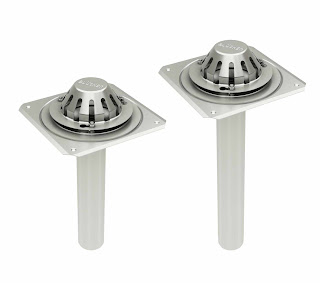Whilst a gravity system is simple to understand, the siphonic system is
a little more complex.
Siphonic roof drainage makes use of the siphoning principle to carry
water horizontally from multiple roof drains to a single downpipe and to
increase flow velocity. Air baffles at the roof drain inlets restrict air
entering the top of the system, which causes the system to run full. The action
of water dropping down the downpipe will cause a negative pressure to form at
the top. This negative pressure can be harnessed to suck water along a
collector pipe installed horizontally connecting the outlets at high level.
There are a number of advantages associated with a siphonic system such as the
reduction in number of downpipes and where they are placed which in turn
affects the amount of internal drainage.
Traditionally manufacturers of roof drains produced either a range for
siphonic applications or a range for gravity applications. However, BLUCHER
produce BLUCHER EuroPipe push fit stainless steel drainage pipework, installed
in both gravity and siphonic applications, and so BLUCHER had a need to produce
a range of drains to cover both gravity and siphonic applications.
 |
| BLUCHER Roof Drains for single ply roof membranes |
Rather than produce two drains BLUCHER have developed one, which with
the inclusion of a simple siphon plate is turned from a gravity roof drain into
a siphonic roof drain.
 | |
| Siphon plate for BLUCHER stainless steel roof drains |
BLUCHER roof drains have outlets ranging from 40-110mm. This covers both
the siphonic applications, which usually run in small diameter, and gravity applications,
which usually run in larger diameter. The Drains are also suitable for both
bitumen and single ply membrane. The bitumen drains have an
option of either pre applied under felt or an under felt flange. For the single
ply drains BLUCHER have taken the additional step to ensure customer confidence
in their products by guaranteeing the water tightness of their 402 range of
drains when they are installed in accordance with the BLUCHER installation
instructions. In addition, the complete range is suitable for both warm and
cold roofs and includes varying length spigots which helps eliminate joints
within the roof structure.
Generally, all roof drainage systems are designed around Rainfall intensity. Rainfall levels are
determined from BSEN 12056-3:2000, using the projected building life plus a
suitable factor of safety. However as the recent downpours have shown sometimes
even the most safety conscious design can be tested. Another innovation from BLUCHER may play its
part in reducing the potential of the roof drainage system to be overloaded.
Looking at the design of the gravity systems it was evident that in
periods of high rainfall intensity there was often a build-up in the head of
water. Usual practice is to install an overflow drain that will attempt to
clear the rainfall should the system become overloaded and this practice should
still stand. However, the BLUCHER design team also wondered whether they could
take advantage of the build-up in head of water and as a result produced the
boost guard for gravity applications.

No comments:
Post a Comment